You can grow a Meyer lemon tree from a seed and start producing fruit in 4 to 6 years. Try this fun project and enjoy the fresh scent of lemon leaves while you watch your tree grow. Here’s what you need to know to grow a productive citrus tree from seed.
Meyer lemon trees are easy to grow from seed. But you won’t find a package of lemon seed at the garden centre. Citrus seeds are only viable for a short time. You must plant your lemon seeds as soon as you harvest them from fresh organic lemons.
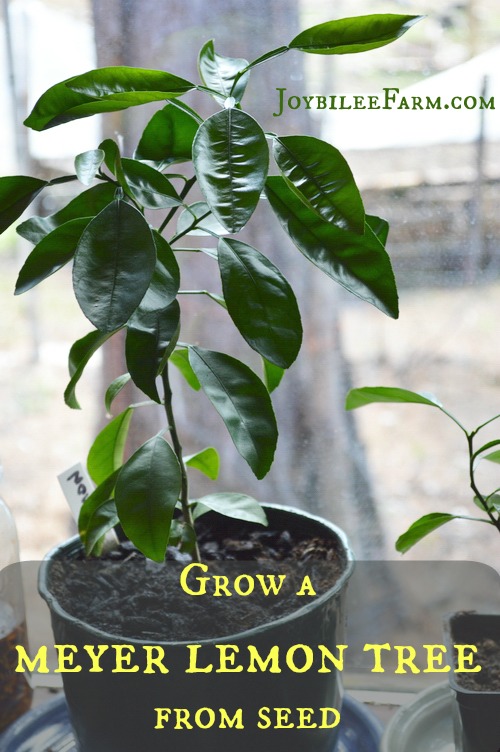
Meyer lemons aren’t actually lemons. They are a cross between a mandarin orange and a yellow lemon, that originated in China. Meyer lemons are one of the sweetest lemons available, with a tart sweet flavor that is much sweeter than regular lemons. Since they share some genetics with oranges they tend to have larger lemons with a globe shape. They’ve been growing in the United States for almost 100 years, originally brought from China by Frank Meyer, an agricultural explorer for the US Department of Agriculture, in 1908. They grow with a bush or dwarf habit and are adaptable to containers. What I’m telling you here about Meyer lemons applies to growing other citrus fruit from seed, as well.
If you are in Canada, choose organic citrus fruit from the grocery store. Nonorganic fruit may have been irradiated. Radiation damages the seed. Another fun seed to try and grow is a date tree, just make sure to take seeds from fresh dates.
If you live in warmer climes where citrus grows, use seed from fruit from a tree growing in your neighbourhood. This will be acclimatized to your growing conditions and give you the very best start.
This winter I receive a gift of Meyer lemons from Angi of Schneiderpeeps, all the way from Texas. The organically grown fruit was freshly picked, and the seed germinated within a week of putting it in potting soil. There was such vigour in that box of lemons that I’ve been passing out Meyer lemon starts to my friends. I was blessed by this generous gift since meyer lemons have low availability in Canada.
Fresh lemon seeds will germinate between 20C and 28C. I’ve had good success germinating citrus seeds indoors without additional heat.
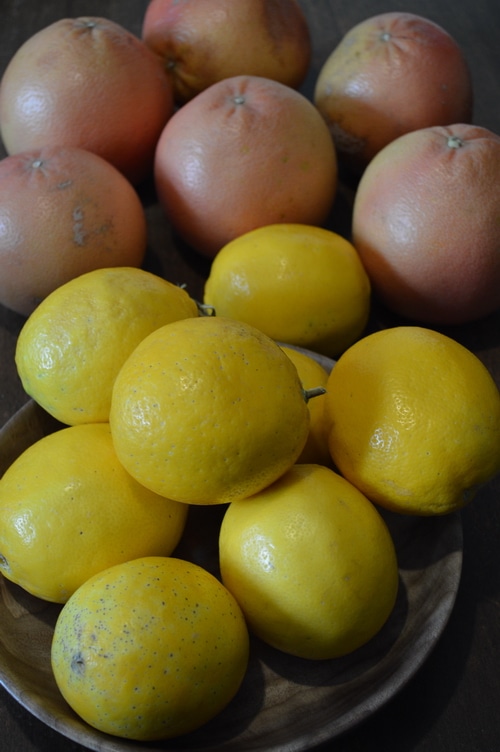
Plant fresh seed
Begin by rinsing the seeds in cold water to remove any sugar or fruit pulp that may cause mold or inhibit germination.
Plant the seed ½ inch deep in potting soil. Cover the seed. Water it. Keep the soil moist.
The seed will germinate in 2 to 3 weeks. Keep the plant soil moist but not wet, in order to avoid damping off the disease. Once the baby lemon trees have 4 true leaves, allow the soil surface to dry between watering but don’t allow the plant to dry out completely. The soil should still be damp when you poke your finger an inch below the soil surface.
Twins!
Normally citrus will grow true from seed. Occasionally, some citrus varieties produce multiple seedlings from one seed – a phenomenon called ‘polyembryony. If this happens, one seedling is the result of pollination and may grow a completely new hybrid plant. The other seedling is an exact clone of the mother plant. With those Texas Meyer lemons, which are a cross between an orange and a lemon, I’ve gotten twins coming from one seed. If this happens to you, let them grow out until they each have 4 leaves and then carefully separate the plants and pot them up separately. Mark them so that you can identify them. You won’t know if you have a new variety of citrus until the trees mature and produce fruit, which will take 5 years or more.

Transplant
Once the lemon trees have 4 leaves, transplant them into 4 inch pots with good drainage holes. Don’t cull your seedlings just yet. A lot can go wrong between now and when they start to produce fruit. If you have the room keep 4 to 6 plants until you see how vigorous they are and whether they have complete blossoms.
Continue to water regularly. Once a month add 1 tablespoon of magnesium sulphate (Epsom salts) to ½ gallon of water and water with that. Do this more often if you see that the leaves are yellowing, a sign of magnesium deficiency.
Soil pH and fruiting with lemons
Lemons like the soil slightly acidic with a pH between 5.7 and 6.5. You can acidify the soil by watering with leftover, cold tea or coffee once a month. Soil should be well drained and light, not compacted. If your tree looks stressed, try replacing the soil with fresh potting soil. Peat moss can be too acidic for citrus, preventing the plant from up taking the nutrients that are available in the soil, yellowing the leaves, and preventing flowering or the setting of fruit. Soils that are too alkaline prevent the plant from taking up nutrients from the soil, which results in yellowing leaves and deficiencies, too. Keep the soil pH in the plant-happy range and the plant will be able to optimize the available nutrients.
At the end of the first year, transplant them into 6 inch pots. And then as they grow, increase the size of the pot gradually until your lemon tree is in a 10 to 12 inch pot. Once the tree is 4 to 5 years old, and 4 to 6 feet tall, you’ll see its first white blossoms. Congratulations. I bet the song “Lemon Tree very pretty and the lemon flower is sweet” will start to go through your head.
Here in BC, Canada, a fruiting lemon tree is around $170 so you are saving about $15 per year of growth by growing your own tree from seed. If your tree becomes root bound you can prune the roots to keep the height controlled.
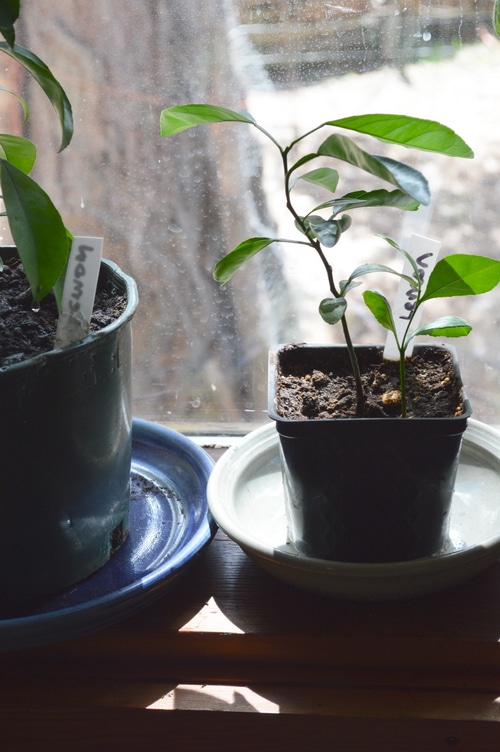
Humidity
Citrus leaves will drop if the humidity gets too low in winter. This is a problem if you are heating with wood and the tree has a sudden change in humidity levels, such as when you bring a tree indoors after it’s been outside on the patio all summer. To prevent shock and leaf drop, keep the humidity level at 45 to 50%. You can increase humidity by using a humidifier, or by keeping a bowl of water next to the growing citrus, in a heated room or by putting the tree in a humidity tent.
How to prune the roots on a lemon tree
After all the fruit has been harvested from your lemon tree, gently remove the tree from its pot. Using a bread knife cut off about 1/3rd of the length of the roots. Replace 1/3rd of the potting soil with well composted but bug free manure or worm castings. Repot in the same pot. Then prune about 1/3rd of the branches to reduce the stress of the tree. Taking the top from the central leader will encourage side branches to develop, so don’t be afraid to cut into the trunk of the tree.
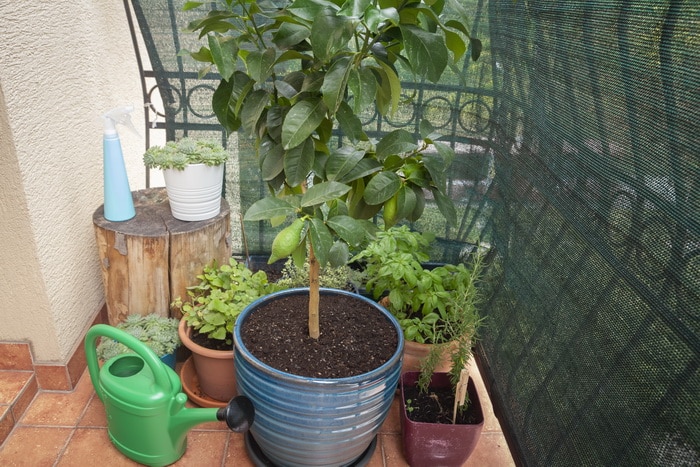
Hand pollinating indoor lemon trees
A lemon tree kept indoors requires hand pollination to allow it to set fruit. Citrus flowers have both male and female parts. You don’t need a second citrus tree to cross pollinate. Citrus trees are self-pollinating. Citrus trees will fruit, even if you only have one tree, provided that you pollinate the blossoms. If you are growing your tree indoors you won’t have bees to pollinate the blossoms.
You can hand pollinate the blossoms by using a soft paintbrush with a fine tip. Gently brush the male anthers, at the tip of each stamen, of the lemon flowers. The anthers encircle the sticky female pistil in the citrus flower. Immediately take the pollen to another flower and brush the female pistil parts of the flower, in the centre of the ring of male anthers. Take up more pollen from another blossom and fertilize the female parts of another blossom. In this way, you will help your citrus to set fruit.
Not all fruit that sets will actually remain on the tree. There is often fruit drop. But citrus trees bloom for a long period, even while they are setting fruit, so you have a good chance of getting mature fruit with hand pollination.
Lemon trees aren’t like apple trees that bloom once in the spring. Lemon trees can have blossoms and fruit at every stage of maturity, all at the same time.
Sometimes a lemon tree will produce male-only flowers. These are the blossoms that have the circle of male stamens with the anthers on the tips, but no central pistil. These blossoms won’t be able to produce fruit, but they will produce viable pollen. Hopefully, you’ll find other complete flowers on the tree that will produce fruit.
Outdoor pollination
You can put your lemon tree outdoors on a deck or patio once the nighttime temperatures remain above freezing. Once outside the sweet smell of the lemon leaves and flowers will attract many pollinators and your fruit set will increase. Sunshine will also increase the fruit set and improve the condition of your tree. Be sure to continue to water your tree outdoors and beware of the expected nighttime lows. You’ll want to bring the tree indoors before the nighttime temperatures drop below freezing. Citrus trees can be damaged by frost.
Lemon leaves and flowers have a refreshing citrus perfume that is an asset to your home and garden. The fruit is lovely and can be grown year round in the greenhouse or indoors. All this benefit for the cost of a seed that you were going to toss in the compost. What are you waiting for?
Growing a lemon outdoors
Meyer lemons thrive in USDA Hardiness zones 8 to 11. They thrive in full sun or about 8 to 12 hours of sunlight a day. If you don’t live in Florida, Arizona, Texas, or California you may want to grow your lemon tree in a pot and bring it into a sheltered spot in the winter. Be sure to give it lots of airflow and nitrogen fertilizer so that it will grow and begin bearing fruit as soon as possible.
How to prune a Meyer lemon tree
When you grow a Meyer lemon from seed the central branch will grow upright but there will be no side shoots to encourage flowering and fruiting. To establish side shoots, cut the central branch and prune the tip from any short side branches that grow. This will encourage more branching to support the fruit. Each place a cut is made, two shoots should come from the cut to thicken the tree.
Meyer lemons flower over a long season, and produce fruit, though the dominant time for fruiting is the early spring. The best time to prune is early in the plants life before fruiting begins. To manage a mature potted Meyer lemon, prune up to a third of the roots and branches to keep it form overgrowing its pot.
How to grow a Meyer lemon in containers
Meyer lemons are well suited to containers. Pot up the plant to a larger container as it matures. It should produce flowers 5 to 6 years after you plant the seed. Prune and repot Meyer lemons after the fruit is harvested from the mature tree.
Getting a Meyer lemon from a nursery
The University of California, Riverside, created improved Meyer lemon tree clones that are virtually virus free. If you want to try grafting clonal meyer lemon buds onto your seedling root stock trunk, genetic clones are available in the USDA citrus clonal protection program. Can you find meyer lemons at the plant nursery? In some areas meyer lemons are sold as potted plants. They are well suited to living in pots, so don’t be afraid to get one and keep it on a sunny patio or balcony, giving it needed winter protection according to your climate. Once mature Meyer lemons are hardier than regular lemons though they are frost tender. They are hardy in USDA zones 8b to 11.
So what are you waiting for?
Once your trees start producing you’ll have lemons growing year round. Plant those lemon seeds.


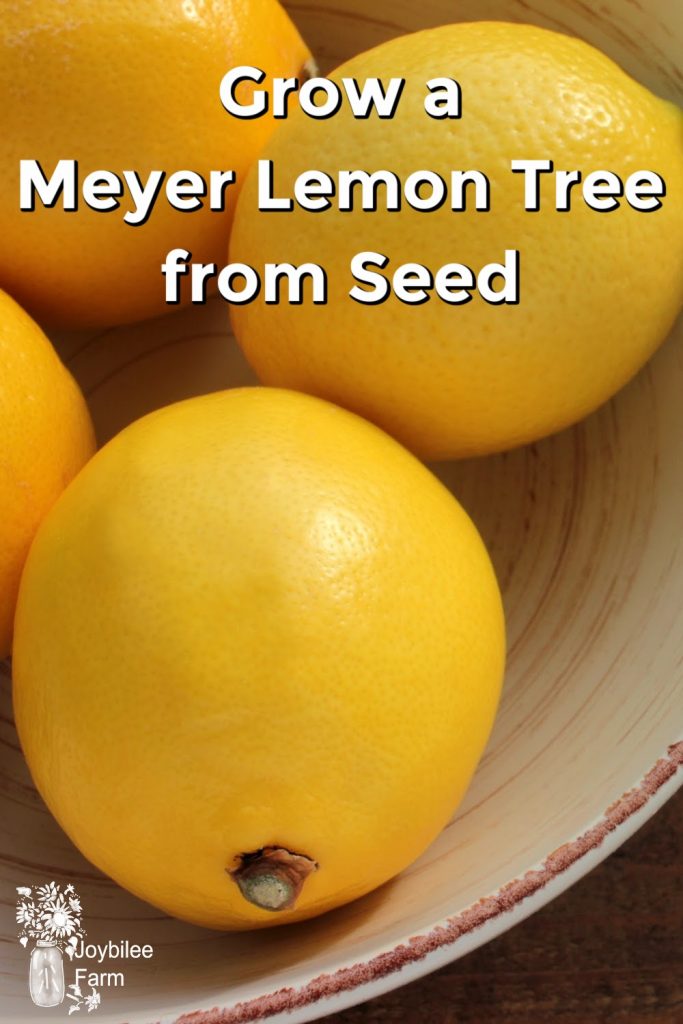

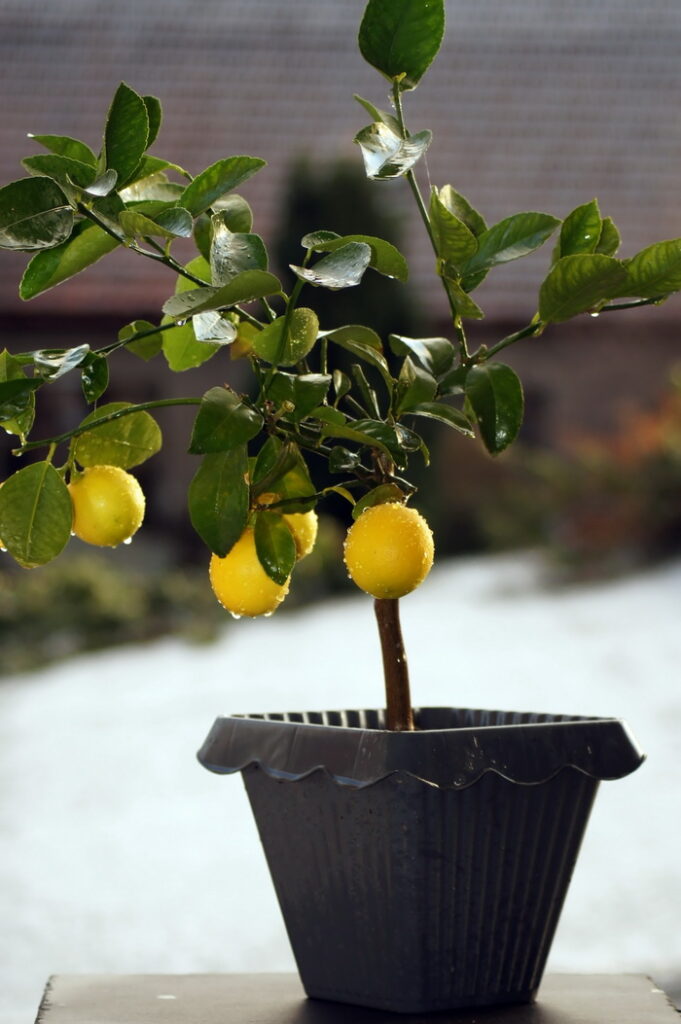

Hi, one of the paragraphs above refers to something called polyembryony. Not sure I spelled it right, but I bring it up to say that the last sentence in the paragraph says that it could take 5 years to produce fruit, so maybe your tree is maturing a little slower than others. I wouldn’t get discouraged yet, there’s a chance your tree just hasn’t had the time it needs to fruit, and with any luck, you’ll see fruit this coming season or the next. My tree is only 2-3 months old, I’m almost embarrassed to call it a tree right now, but hopefully it’ll mature very quickly.
Good luck to you.
Hello. About 5 years ago, my son and I planted a lemon seed. The tree is about 9 feet tall now! We live in the mountains in Pennsylvania, so it remains in a large pot and stays indoors until the warm summer months. It’s a big bright beautiful green tree, but never gets flowers, so it never blooms. Is there something we did wrong, or is normal and not all lemons are created equal?
Hi Laurel,
Yes, scale insects are a pain. We are just across the water from you in southern Vancouver Island, so have much the same climate as you. And the same bugs! We’ve found the following steps help:
1) For a bad infestation we set up the hose to create a gentle spray over the plants and go from leaf to leaf rubbing off the insects by hand. This can be tedious, but, if repeated two of three times over the space of a couple of months, can be pretty effective. It’s also more pleasant to do that using an oil to wipe off the leaves, which I’ve found to be no more effective than water.
2) Citrus don’t like wet feet, but do like to have a morning mist. We’ve found that a regular spray with the hose (but not so much that the soil is always wet) helps to control the insects. Literally a couple of seconds of light spray is all I use. There’s no need for this if the leaves get damp anyway, through rain or dew, but it does seem to help on hot summer days. Don’t spray in the middle of the day though, or the sun may scorch the leaves.
3) Our citrus spend as much time outside in the sun and rain as we can manage. They live under cover from early December to mid-March, and the rest of the time they are outside in the suniest place I can find (though occasionally I need to drag them into the garage if a frost is forecast). Three years ago we had quite a lot of trouble with scale insects; two years ago they were less numerous, and this year they are almost completely absent; we think that the combination of gentle spraying and outdoor living has provided an environment that the plants like and the insects do not.
4) Like all plants, the healthier the plant the more likely it is to be able to fight off attack, so anything you can do to encourage strong growth will help.
I grow a few types of citrus in my back garden on Vancouver Island, with varying success. The main challenges are frost and overwatering. The plants require winter protection, even in the south island, and obviously yours will in Alberta.
Overwatering is not a problem if you have a really sheltered site and can grow the plants in the open garden (a few people here do this successfully, though I have no open site that’s sufficiently protected), but for plants in pots overwatering is a concern. It is wise not to use too generous a pot size for the growing plant. Using a big pot for a small citrus might seem a good idea, but these plants do not like soggy roots, and if a small plant finds itself in lots of soil, the soil may remain wet for several weeks. Eventually the roots can start to rot, which can be fatal.
I transplant each spring, if the plants have grown well the previous year, but only to a pot one size larger.
Now that you’ve transplanted into a 5 gal container I’d leave the plant where it is, especially if it looks as though it’s thriving, but be careful not to overwater, and avoid leaving the pot in standing water.
I transplanted my lemon tree into a 5gallon bucket. Is that too big? It’s sprouted 3 new leaves in 1 week of
Transplanting.. seems to love the big bucket.
Thanks for all your info- out here in Alberta